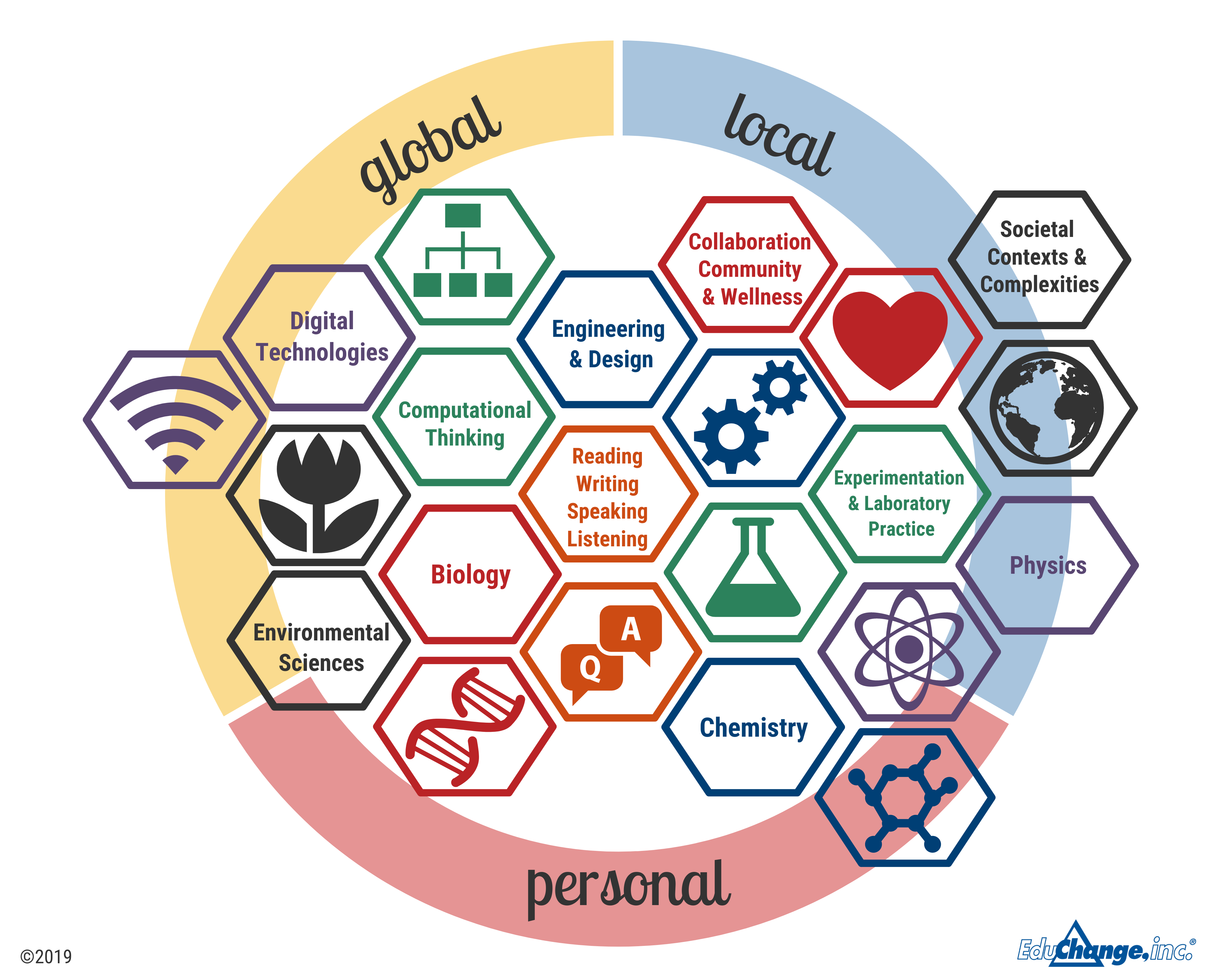Content Integration & Learning
The Personal, The Local, The Global
During our time spent in dialogue with world-class researchers at The Rockefeller University, a few things crystallized. For one, the pursuit of questions and solutions, in its purest form, is an interdisciplinary endeavor. Every one of our scientific peer reviewers, some of whom we’ve acknowledged publicly, has confirmed these same observations and applauded us for helping students to build a holistic picture, not only of the STEM enterprise but also of nature itself.
It speaks volumes that literally not one active STEM practitioner from industry or university with whom we have connected has ever objected to our integrated approach for ages 13-20.
You may notice that a growing number of STEM professionals today hold interdisciplinary titles, such as biogeophysicist, computational geneticist, astrobiologist, and agricultural engineer. And recently the National Academy of Sciences, Engineering & Medicine advocated for a shift toward integration in tertiary education.
This does not mean that specialized knowledge is not valuable, it merely indicates that the types of questions and problems worthy of attention (and funding) often probe multivariate scenarios that cannot be contained in a single silo.
Society’s most pressing global issues are integrated, not only across disciplines but across cultures, demographics and regions.
An open, dynamic, connected world is the one we need to prepare students to negotiate—even if they never leave their hometown.
Breaking down silos horizontally seems to highlight layers of vertical connections for practicing STEM professionals as well. We have observed, and they told us about, their personal, local and global motivations for pursuing their craft.
Some are on a quest to cure cancer because a family member has suffered; others remove abandoned fishing gear by hand to preserve the beauty of marine waters they loved as a child; still others forge sustainable agricultural solutions to help reduce regional conflict and improve economic possibilities.
The STEM professionals we know are personally attached to and affected by the work they do daily. They act locally within their communities, and they participate as part of a global network of professionals who challenge and learn from one another.
This was such a powerful pattern that emerged in our collaborations, one I knew we had to find a way to recreate through our designs.
Content connection across disciplines, multiple levels of meaning-making, the underlying humanity, the social construction of knowledge.
This was real STEM.
Layers of Threads, Multiple Opportunities
Driving content organization through real-world issues and contexts rather than textbook topics is exciting, but not as easy as some may imagine.
Project-based or problem-based learning (PBL), which we embed extensively into our instructional system, encounters friction in upper secondary schools when it faces siloed course content requirements.
Teachers have trouble conducting time-intensive projects that also cover required content, which is a major reason why PBL blossoms in K-8 core curricula but struggles to take root in upper secondary levels.
To take PBL for a spin, out of genuine interest or to appease administrators, teachers quickly see the need to step outside of their siloed subject area.
Some teachers conduct one interdisciplinary project per year, while others make a few integrated connections within several units.
From a design standpoint, this solves no problems, since either approach to partial integration forces teachers to add time into an already-packed curriculum, and possibly to lose other content in the process.
Integrating a ‘little bit’ here and there doesn’t provide the best of both worlds.

Integration over multiple years literally breaks open the learning architecture, allowing designs to be driven by the authentic STEM we observe in our professional collaborations, while still meeting course content requirements within given timeframes.
Be forewarned: content integration over multiple years does not automatically resolve the content organization challenge. To benefit from truly open learning architecture, designers must grapple with hundreds of variables simultaneously. I believe this is often why teachers who are strapped for time find it difficult to undertake an integrated model at the upper secondary levels.
They quickly discover that units and projects, which structurally behave the same way regardless of the instructional practices contained therein, may no longer be designed serially.
You can’t wrap one project in a bow and move on to the next.
Instead, imagine dumping the contents of a giant LEGO® box on the floor, never removing any bricks, selecting certain combinations of bricks to build structures based on a given global issue, and leaving space for teachers and students to add their own bricks as it suits them.
That more closely resembles the design of a completely integrated course.
The interconnectedness of the content requires keeping your hands in multiple units simultaneously. Thus, several units are designed together, iterated together, tested together, and iterated yet again when more units are added.
This holistic approach is far more demanding for designers working with content coverage constraints, but we saw its tremendous potential for learning and never looked back.
By threading more difficult and abstract concepts over two or more years, students encounter multiple opportunities to deepen understanding.
The one-and-done designs currently implemented in siloed courses, due to sheer time pressures, do not support what we know about how individual adolescents learn, much less an entire classroom of diverse learners.
By creating conceptual threads, we support diverse classrooms by optimizing conditions for learning without dictating the exact timeframe for every ‘a-ha!’ moment.
This remarkably powerful architecture directly fuels the design of an equitable assessment system, and aligns with adolescent development as well. Adolescence is a period of active neural pruning, the removal of cognitive connections that are not used repeatedly. The neuroscience behind “use it or lose it” is real, and a multi-year schedule of integrated content organization affords an opportunity to work with nature, not against it.
At the same time, it is critical that learners do not experience this review of concepts as boring repetition or meandering exercises, which was a problem during certain elementary mathematics program implementations.
To reinforce and deepen understanding in our program, a macro-level of organization must govern the design. This is a major rationale for our 20-year maintenance of five strands, as well call them. Strands are big themes that house related issues and contexts within a group of learning modules.
When students in our program revisit the same concept in another strand, it feels like application rather than repetition, likely due to the fact that the concept has been permutated with other conceptual threads to emphasize nuanced, or even novel, meaning.
And when each context describes an important health, technological or environmental scenario, students make personal and local connections that underscore the “why” of the learning.
It is this multivariate, integrated, threaded, contextualized design that increases STEM confidence without inducing boredom.
“There has never been a day of something I didn’t want to learn,” shared a sixteen-year-old student.
Perhaps most satisfying of all, conceptual threads may be layered in ways that reflect the depth and richness of nature itself.
As STEM practitioners know, the closer you look the more you see. We take great delight in providing rabbit holes for interested students to crawl down, understanding that different students will choose different moments for their closer looks (thus, there are never ‘required’ rabbit holes).
Grabbing bricks from the life, material, physical and environmental sciences simultaneously enables us to layer different concepts according to the appropriate developmental level, as long as they fit within the chosen context.
Certain concepts are seeded when others are sprouting; still others hold steady but need nourishment to thrive. Students who are ready to notice the seedlings will delight in their appearance, while others who need to attend to the familiar are encouraged to water that soil.
Layers of conceptual threads within a single unit of study contribute significantly to a unified, socially constructive classroom experience that also empowers personalized learning experiences.
Strong models of integration attend to sequence.
Sequence matters for building conceptual knowledge, and must remain central to any designs for learning.
We position certain issues at certain moments in the program to ensure the layers of concepts described above can stay true to the context, to the disciplinary concepts, and to the developmental stage of the learner.
This is no easy feat.
To further complicate matters, every discipline has threshold concepts that act as gateways to more complexity.
It is important to identify these concepts, to attend to them through assessment and feedback, and to approach them with the disciplinary respect they deserve.
There are certain mechanisms of heredity, for example, that one must understand in order to appreciate the risks and benefits of certain biotechnologies.
Working with an international cadre of practicing STEM professionals certainly helps calibrate and improve the integrity of our program.
Creativity is Connectivity
I would be remiss if I didn’t highlight the ways in which a multi-year integrated design supports creativity, and it’s a good final point for this post.
There are many myths about how creatives work and what fosters creativity, so we ground ourselves in neuroscience, which describes creative brains, in part, as those that display extensive white matter networks when imaged.
The brain’s white matter helps connect ideas and information, and stable knowledge networks are built through multiple opportunities for retrieval and reinforcement.
Adolescence, now believed to extend into the mid-twenties, is a period of high neural connectivity.
And creative outputs, such as a work of art or a technological invention, benefit from long periods of incubation and under-the-radar activity.
By designing learning systems that resonate with natural neural development, we can support rather than squelch creative brains in the making.
Suggested Citation: Saldutti, C. (2019, June 20). Content integration & learning. 1-2-3 Learn: EduChange Design Blog. https://educhange.com/content-integration-learning/
We’ll let you know when the next post is ready for you!



